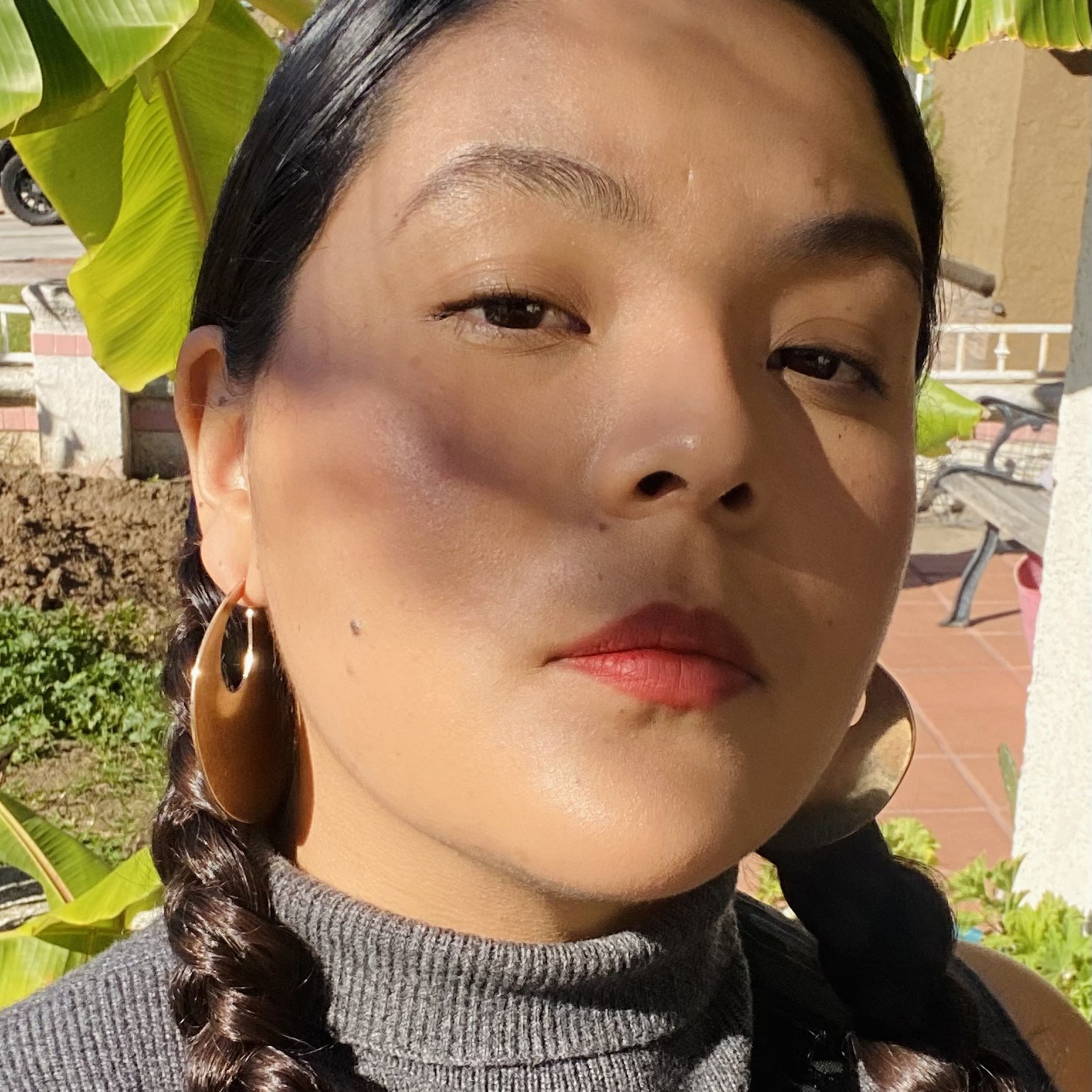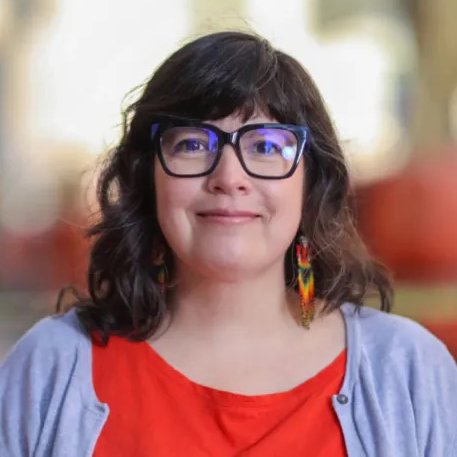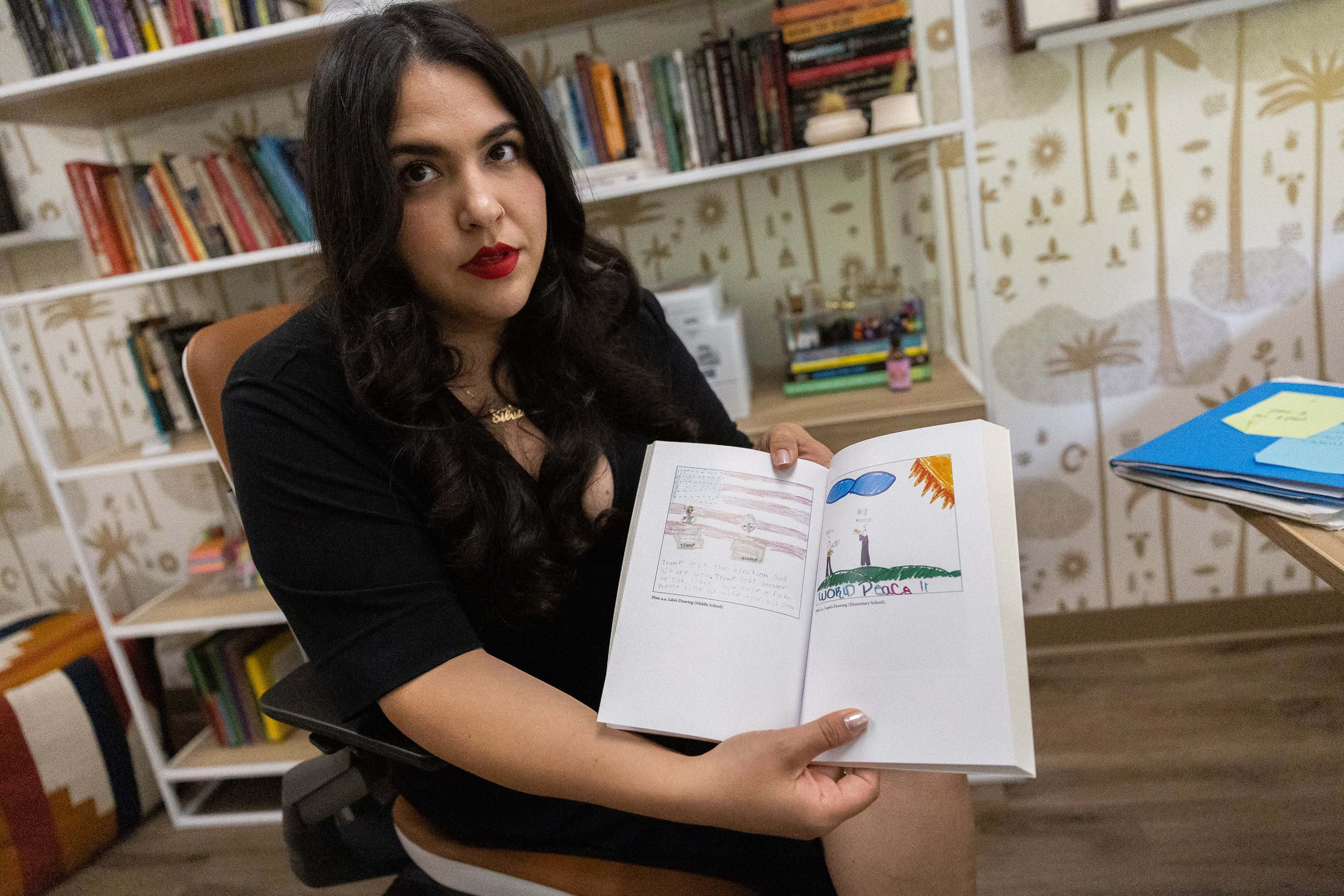Children Drawing Deportation
“Drawing Deportation” author Silvia Rodríguez Vega, shares the catalog of children's drawings collected over the years. on June 29, 2023. Photo by Julie Leopo for palabra
Silvia Rodríguez Vega made a promise to herself after working with children who drew their own fears. The result is a book that shows the powerful effect of art as healing
Editor’s note: We’ve used fictitious names to protect the identity and privacy of the children mentioned in the article.
Haga clic aquí para leer el reportaje en español.
“When you imagine peace, how do you see it?” Silvia Rodríguez Vega asked her students at a summer camp. The answer felt like a kick in the stomach. “Peace is Sheriff Joe Arpaio shaking hands with a Mexican,” said Chris, 9, a brown-skinned boy who was a little shy but vocal, referring to the tough sheriff in Arizona he saw on the news who was known for a hardline policy on immigration.
Silvia wanted her elementary and high school students to paint a mural and that is why she asked the question. She let them choose the theme and they chose Chris' response as the subject to paint.
One envisioned a Mexican day laborer named Pancho as the central character; the farmworker would shake hands with Arpaio.
This happened in a community center in the majority Latino area of south Phoenix. At the time in 2008, Silvia was 19 years old and studying Political Science and Chicano Studies at Arizona State University. It was a difficult time, with constant raids in Arizona.
There were agents who detained brown-skinned workers and drivers for minor traffic violations; some were even stopped for having a broken windshield and ended up being deported to their native countries. People were detained for speaking English “with an accent.” They deported people who used a fake ID for work. Undocumented immigrants were prosecuted with the same harshness as the smugglers or human traffickers (relying on their interpretation of a state law that the media dubbed the Anti-Coyote Law). The Spanish translations disappeared from official sites. And a Latino could be arrested just for looking Latino.
‘I had to create a way for people to see that, and for the experiences to not just stay with the children.’
Arpaio also created a prison in Phoenix with tents in which immigrants, the majority imprisoned for minor crimes, endured the high temperatures of the desert and were forced to wear pink underwear.
In an environment of segregation and a powerful anti-immigrant narrative, fear seeped into these children's homes, their schools, and their hearts. A handshake between the Maricopa County sheriff and a Mexican meant world peace for them; the possibility of not being separated from mom and dad.
Silvia shares a page from her book "Drawing Deportation” with a drawing from an elementary school student about her vision of world peace. Photo by Julie Leopo for palabra
Silvia thought that a mural could help the students channel their emotions, but the project was not accepted by the community center as they found it controversial. The children felt sad and disappointed, so she offered them sheets of paper and invited them to freely express what they felt.
"When I left there, I was shocked to see not only drawings of the sheriff, but also of the police, how they can't drive, how they can't leave their homes," Silvia says 15 years after that initiative of hers.
“I felt a responsibility and commitment for all to see them. I had to create a way for people to see that, and for the experiences to not just stay with the children.”
That day, publishing a book became her main goal.
Art and education go hand in hand
One spring night in 2023, Silvia Rodríguez Vega sat down in an auditorium in Arizona to present what had been promised. “Drawing Deportation” (NYU Press, 2023) is the book she worked on these years, a compilation of the 2008 Arizona drawings and others made in California in 2016. Years of persecution and deportation with Arpaio, with Barack Obama, and with Donald Trump.
Silvia prepared herself well before unlocking and showing people the tracings of the students with whom she has connected through drawing and theater. In 2010, she completed a Master of Arts in Education at Harvard University, studying trauma and how art can be a pathway to liberation for children and adults.
Children feel safe expressing their emotions through art; creative expression reduces cortisol levels and lowers stress.
Students participate on a collage making workshop by Aliento. Photo courtesy of Aryam García
“When they have a lot of stress, it can become toxic stress that affects their brain, their immune system,” she adds, “it makes them unable to learn at school or they make bad decisions.”
Most families know that art is good for their children. In the United States, about two-thirds of parents of students in preschool through 12th grade (66%) say it is “extremely” or “very important” that their children be taught social and emotional skills at school, according to an October 2022 Pew Research Center report.
Silvia points out that, in her experience, the school districts in Arizona and California where she has served are not committed to art classes that emotionally benefit children in their personal and academic development.
A report from the Arts Education Data Project finds that two million public school students in the United States do not have access to any type of arts education. Additionally, 3.6 million do not have any kind of musical education. Theater and dance are the least taught arts. The report shows, above all, inequity in schools with more children enrolled in the free lunch programs that have a greater black, Hispanic, or indigenous population.
Sadly, Silvia says, Latino immigrant students were and continue to be the most affected. “The schools where art is most needed are in poor and immigrant communities where children deal with things not just related to immigration, but also violence, gangs, diseases,” she says with frustration. She knows that these classes could change someone's life.
Education specialists say that art plays a fundamental role in educational development in preschool, elementary, middle, and high school (K-12).
Stephanie Parra, executive director of ALL In Education, an organization that fights for equity in education, emphasizes that these classes have an impact on mental health and generate wellbeing that is directly related to academic success. "Students can develop additional skills and talents, essential to explore their interests and enhance them, as well as get information to make the decision of what career they decide to study,” says Parra.
An immigrant girl touched by art
Silvia was no different from the children who drew their deepest fears. “I was undocumented,” she says openly about her personal history. She was born in Chihuahua, Mexico, and came to Phoenix, Arizona, with her parents when she was 3 years old. Her younger siblings, Víctor and Alejandra, were born in the U.S.
Silvia Rodríguez Vega, author of "Drawing Deportation," at UC Santa Barbara. Photo by Julie Leopo for palabra
Arpaio's raids also affected her mother María so much so that she suffered a stroke; the doctors warned María that she needed care, so she decided to return to Mexico. Silvia was left in charge of 15-year-old Alejandra, just when Silvia was studying for a master's degree at Harvard. The way she got the money to go to Harvard describes her drive, her work, and her stubbornness.
When she was younger, she was a "Dreamer," beneficiary of the Deferred Action for Childhood Arrivals (DACA) program, which then-President Obama created in 2012 to protect them from deportation. She and her classmates helped each other with fundraisers to continue their studies. They could not access loans or scholarships. When it was her turn to raise the money for Harvard, she was inspired by the immigrant rights activist Dolores Huerta, and one day Silvia opened an account on the popular fundraising site GoFundMe with a motto, "Harvard, Yes You Can.”
They interviewed her on news programs like “Primer Impacto” and that gave her visibility. But what helped her the most was appearing on the "Don Francisco" program. After that, she received messages of support, questions, congratulations. A writer from Peru, for instance, wanted to know how to get their son into college; in exchange the writer offered to edit the book with the children's drawings when she published it. Silvia talked about her dreams in those programs, and the biggest one was still the one in the book. For Harvard she needed to raise $80,000 and she managed to raise $60,000.
Silvia became very interested in art because she found salvation along that path.
Resilience and healing
When she was 13 years old, Silvia took drama classes under the tutelage of Christina Marín, a New York teacher of Colombian descent who continues to work with immigrant children and directs the Theater and Film Program at Phoenix College.
If Silvia had not had an escape like the one offered by art, perhaps her story would be different, Marín tells palabra. “Many people fail to overcome trauma. They start to get depressed, take pills or drugs to calm their anxiety, but Silvia took the example that I taught her and now she is doing it for other young people who have come after her.”
Silvia followed, step by step, her example. When Silvia was her student, Marín was working on a thesis on social change that earned her the Arts-Based Educational Research Dissertation Award, a distinguished honor given annually by the American Educational Research Association (AERA). Years later, Silvia would study for a master's degree in art and would receive the same recognition; in that case, for the psychological-emotional analysis of art in immigrant children.
‘Being an immigrant entails feelings of loneliness, anxiety, displacement.’
The examples of Marín and Silvia have inspired other women. Aryam García does not personally know the author but she saw her book, “Drawing Deportation,” on social media and it resonated with her so much that she now promotes it in her own community. García is originally from Nogales and is also a Dreamer. She finds the book tough: "It's not fair that children have to develop those resilience skills at such a young age."
"Drawing Deportation," by Silvia Rodríguez Vega showcases hand-drawn images by immigrant children depicting their experiences. Photo by Julie Leopo for palabra
At 24 years old, García coordinates the Art and Healing program of the Aliento organization, an activity open to children, youth, and adults. She works with DACA youth just like her. With her group, they teach that a person’s legal status does not define them as human beings, and they go to schools and invite students to draw with a healing sense.
García laughs when she talks about her birthplace. With only a few hours of travel geographically, she would be American, just across the border, she says it with humor. She immigrated with her parents to Arizona when she was 8 years old, and comments that immigrants often cannot control things that happen, such as deportation, police arrests, or an eventual end to DACA. "But what we can control is how we express ourselves, how we let our emotions and thoughts help us develop."
That is work. Since she was young, she has been interested in brain development and mental self-care. Art, she says, helps to recognize oneself in a community and strengthen the sense of belonging. She paints whenever she can.
In a year, García will finish a Psychology degree at Benedictine University in Mesa, Arizona.
"Being an immigrant entails feelings of loneliness, anxiety, displacement,” she contends. And she is convinced that if students are given access to art, they will also be given access to an emotional outlet.
The promise of a book
Silvia was in Los Angeles when Donald Trump was elected; she was there for doctoral studies after getting her master's degree at Harvard. In that state, as in Arizona, she saw the fears that she had already seen in migrant children and one more: the fear they felt of classmates and teachers who supported the idea that Mexico would pay for a border wall and that immigrants leave the country.
She studied for her doctorate in the mornings and in the afternoons worked in an art program in school districts with sixth graders who had lived through very tough experiences.
"Not only was it bullying," says Silvia, "they felt insecure." Insecure, because of that polarizing and racist environment.
Unlike the mural in Arizona, here she asked the sixth graders to draw what they had done over the weekend: a girl drew a Mother's Day without her mom; she had not seen her for two years because she lived in El Salvador. Other youngsters drew sad faces and lots of tears, like streams of water coming out of their eyes. Others used only pencil, no color. “That is a way of communicating isolation,” Silvia explains about the absence of colors.
The one that struck her the most was that of a boy sitting in the bottom corner of the sheet of paper, with his hands covering his face. It continues to move her as she describes it.
A handwritten note recounts the events of 17-year-old Alex's tragic immigration story from El Salvador to the U.S. as told by his younger cousins through a play they created. Photo by Julie Leopo for palabra
In the decade from 2008 to 2018 in Arizona and California, two different places but the same reality, she collected 300 drawings. They are not all published in her book, but she continues to treasure them all. "The most valuable (treasure) I have had in 15 years."
The cover drawing of her book is of 11-year-old "Mario.” It's a fence with sharp spikes on top and a helicopter that shines a yellow-orange light on an immigrant; on the right side, a bus with detainees looking through the windows with bars on them. “No child should know what that is,” Silvia asserts. “It causes me great pain.”
Above all, the promise of the book came with her younger brothers in mind. She wanted to do something for them. “I saw on a daily basis the experience of what it means to live with Sheriff Arpaio, day by day. I physically felt the power of the image that the boy (Chris) described,” she notes. "What we experienced in Arizona became something national; that same thing became nationally normalized."
Silvia now has legal status, is married, and works as an adjunct professor in the Department of Chicano and Chicana Studies at the University of California, Santa Barbara. And she is convinced that a change must be supported so that this story does not continue to repeat itself.
“The United States has always been separating families, it is not something new. Sadly, it's not going to stop happening until we decide that has to change,” she says, with hope.
Maybe the change comes from art.
—
Beatriz Limón is a journalist and photographer at Arizona Luminaria. She was a correspondent in Arizona and New Mexico for the EFE International news agency. She has a degree in Communication Sciences and is a columnist for the newspaper El Imparcial, and a contributor to palabra.
Julie Leopo is a California-based award-winning photojournalist who explores culture, politics, identity, and social issues and has a passion for amplifying the stories of bicultural and bilingual communities through her photography. In 2021, Latino Journalists of California, CCNMA named Julie one of “California’s Most Influential Latina Journalists,” and in 2022 she was a runner up for the prestigious Ruben Salazar Journalism Award for her reporting on the Oxnard beach community.
Wendy Selene Pérez is a multiplatform freelance journalist who has reported and edited for newspapers, magazines, and digital media in Mexico, Argentina, and the United States. She is a recipient of the National Prize for Journalism in Mexico (2019, 2022) and the UN Breach/Valdez Prize for Journalism and Human Rights (2023).













